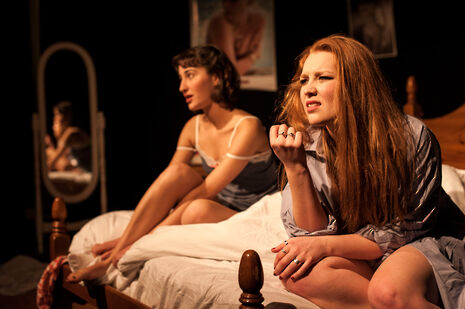FREAK
Tense and thought-provoking, but at times imbalanced in tone, says Cara Atkinson

In the opening moments of FREAK, Georgie (Eleanor Mack) writhes while recounting a dream of dancing dressed only in gaffer tape on the fourth plinth of Trafalgar Square. She then imagines herself in New York, wrapped in the grasp of King Kong and about to be violently used, maybe destroyed. This confrontationally sexual moment sets the tone for the rest of the play – soon her monologue is succeeded by fifteen-year-old Leah’s, who anxiously Veets her pubic hair every day in preparation for when Luke sticks his hand up her skirt at breaktimes and watches Rihanna videos to learn how to present herself as sexy, and as sexual.
For FREAK the Corpus Playroom has been transformed into a shared bedroom, complete with a double bed, crumpled cigarette packets on the floor, and pants hanging from bed knobs. The effect is stunningly intimate and is supported by the soft lighting, occasionally punctuated by more vibrant hues for effective, if not always perfectly timed, emphasis during several gyrating dance sequences. These sequences quickly become uncomfortable to watch but, in a play that is so concerned with how female sexuality is defined under and against the male gaze, clearly that is their point.
It is this skillfully displayed tension – between empowerment and subjugated display – that powers the play through imbalances created by the relatively pedestrian nature of Leah’s first sexual encounters compared with Georgie’s experiences dancing in a strip club and her subsequent, and potentially upsetting or triggering for some audience members, violent sexual exploitation. Although the sexual and emotional journeys their characters undertake are very different, both Mack and Dubow express a compelling mixture of bravado and vulnerability, making what could be a mere catalogue of sexual fears, exploits and thwarted desires instead profoundly affecting.
However, other imbalances in tone prove somewhat harder to overcome – once the monologues have interwoven the play slips into more naturalistic drama as the two protagonists’ stories blend into one. At times, it felt a little as though the actresses spoke past rather than to each other and the dynamism of the first section sat unfavourably against this far more static scene. This was particularly evident in the ending, which suffered from the lack of a brave directorial decision to prevent the production from simply petering out – a disappointing conclusion to a production that is disruptive, disturbing and, at the same time, deeply familiar.
 News / Fitz students face ‘massive invasion of privacy’ over messy rooms23 April 2024
News / Fitz students face ‘massive invasion of privacy’ over messy rooms23 April 2024 News / Climate activists smash windows of Cambridge Energy Institute22 April 2024
News / Climate activists smash windows of Cambridge Energy Institute22 April 2024 News / Copycat don caught again19 April 2024
News / Copycat don caught again19 April 2024 Comment / Gown vs town? Local investment plans must remember Cambridge is not just a university24 April 2024
Comment / Gown vs town? Local investment plans must remember Cambridge is not just a university24 April 2024 News / Cambridge University disables comments following Passover post backlash 24 April 2024
News / Cambridge University disables comments following Passover post backlash 24 April 2024




